Recruit warriors and scouts, and send them to explore. Protect your territories from rival clans, and be sure you have enough food for the winter!
What Is Northgard: Uncharted Lands?
Northgard: Uncharted Lands is a 4X deck-building game for 2 to 5 players, ages 13 and up, and takes about 45 to 90 minutes to play. It’s currently seeking funding on Kickstarter, with a pledge level of €50 (about $60 USD) for a copy of the game, or €70 (about $83 USD) for the collector’s edition that includes the Warchief expansion. The game’s theme includes warfare but the illustrations on the cards generally don’t show any graphic violence; I think the gameplay would be appropriate for experienced kids perhaps 10 and up.
Northgard: Uncharted Lands was designed by Adrian Dinu, published by Open Sesame Games, and illustrated by Grosnez. It’s based on the Northgard videogame from Shiro Games, though you don’t need any experience with the videogame to play the tabletop game.
New to Kickstarter? Check out our crowdfunding primer.
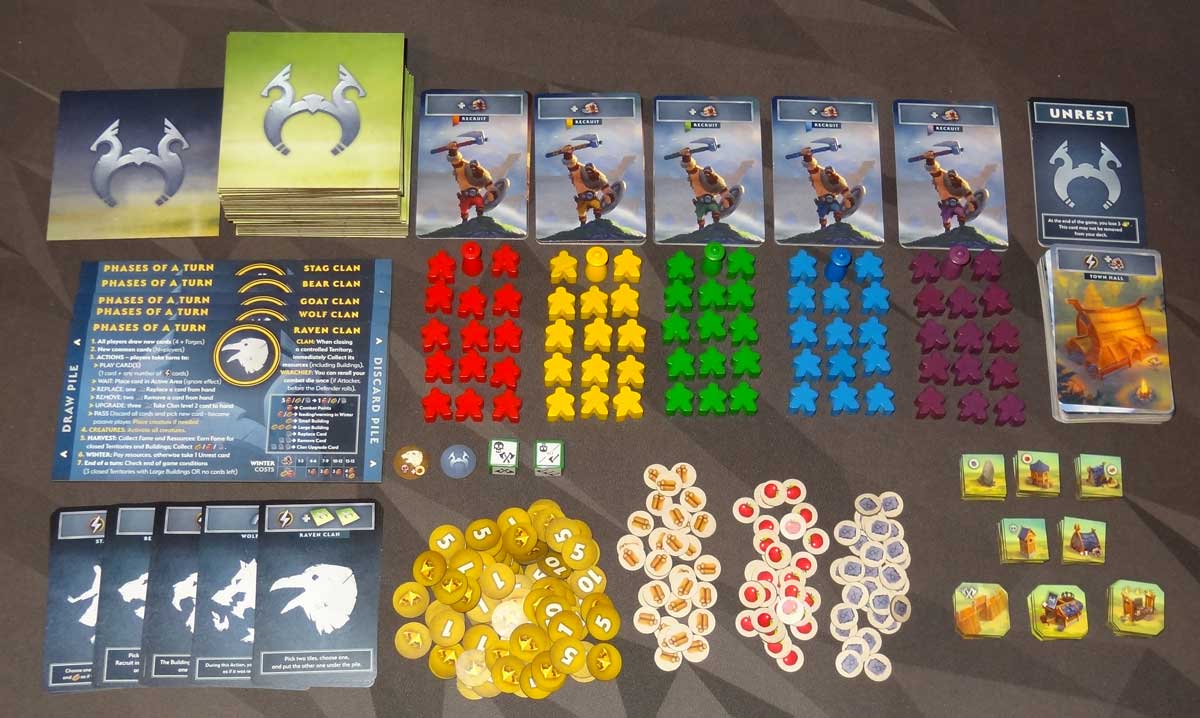
Northgard: Uncharted Lands Components
Note: My review is based on a prototype copy and Tabletop Simulator, so it is subject to change and may not reflect final component quality. A few things that will definitely be different in the finished version: the meeples will be replaced by custom plastic miniatures. Also, some of the cards (such as the Unrest cards) in the prototype were not yet illustrated and just had the Northgard logo, but will be fully illustrated in the finished game. Finally, the territory borders will be more visible in the finished game; some of my photos show wooden bars that I placed to make them more obvious.
My photo above includes components from both the core game and the Warchief expansion.
Here’s what comes in the core game:
- 35 Map tiles (including 1 starting tile)
- 30 Starting cards (6 per player)
- 10 Unrest cards
- 73 Development cards
- 18 Clan cards (3 per clan)
- 70 Viking miniatures (14 per player)
- Kaija Bear token
- First Player marker
- 2 Combat dice
- 60 Fame tokens
- 60 Resource tokens (20 each Wood, Food, Runes)
- 56 Building tokens
The Warchief expansion includes:
- 6 Warchief miniatures
- 5 colored bases
- 5 Combat dice (colored)
- 6 Clan upgrade cards
- Kaija Bear miniature (with 5 colored bases)
- 5 Modular Player/Clan boards
- Turn Tracker board
Note that there are 6 clans (one was added as a stretch goal) but the game only goes to 5 players, which is why there are only 5 sets of colored components. In addition, all Kickstarter backers may receive some additional content based on stretch goals, including the Creatures of Northgard expansion and additional clans, though I did not have access to those for my review. Be sure to refer to the Kickstarter page for the most current information.

I really love the illustrations on the cards in Northgard. The cards primarily use icons, so there’s a bar across the top with the icons, and sometimes a box at the bottom with some additional explanatory text, but the bulk of most cards is an illustration. The style is a little cartoony and exaggerated, and shows Viking characters engaged in various activities. I particularly like that it includes both men and women at work and in combat. The cards are colorful and eye-catching.

The map tiles are pretty large, about 4″ square (at least in the prototype). That means they’ll take up a good amount of space on the table as you start building out the map, but considering the number of Vikings you might need to squeeze into a territory, the size is appropriate. Just be sure to leave plenty of room around the center tile for the map to grow.
The prototype included meeples and pawns for the Vikings, but you can see the designs for the miniatures on the Kickstarter page. There are two different poses for the regular warriors in the player colors, and then the warchiefs all have unique sculpts in a larger size so they stand out. A nice touch is that the warchiefs will be white plastic, with colored bases that snap on, so that you’re not stuck with specific color/clan combinations.

I was a little surprised to see that the player boards (which have the turn phases and clan powers) are not included in the core game, but only in the Warchief expansion. Hopefully, the core game will have some sort of player aid card if it doesn’t include these. The finished version of the player boards will be two-piece modular boards: the left side includes the player reference and the player color; the right side has the clan icon, clan power, and warchief ability. Like the colored bases, it’s an extra consideration that allows players to mix and match colors and clans, in case you have a favorite color but don’t want to be stuck playing the same clan every time.
How to Play Northgard: Uncharted Lands
You can download a copy of the rulebook here.
The Goal
The goal of the game is to be the first to control 3 closed territories with large buildings or score the most points in 7 rounds.

Setup
Place the starting tile (which has a different back) in the center of the play area, with the rest of the tiles shuffled in a face-down stack to the side. Place all of the building tiles, the resource and fame tokens, and the Unrest cards in a supply. Shuffle the development cards and put 7 cards per player into a deck, returning the rest to the box.
Each player takes 14 warriors, 6 starting cards, and their 3 clan cards. (Note: the Tabletopia module and my prototype included the warchief expansions, so the images also show the clan sheets and the warchief miniature.) The 6 starting cards are the same for each player, but marked with their player color, and show the four primary actions in the game. (Everyone also has 2 Feast cards, which let you choose any of the four actions.) Shuffle your 6 starting cards and your level 1 clan card to form your starting deck. Set your level 2 clan cards aside for now.
Choose a starting player and give them the first player marker. Each player will get some starting resources based on turn order.

Then, each player will draw a tile, add it to the map, and place 3 of their warriors in one territory of that tile to create the starting map.
Gameplay
Northgard is a deck-building game, so each player has their own personal deck and discard pile. If you need to draw cards and have none left in your deck, shuffle your discard pile to form a new deck and continue drawing.
The game will take up to 7 rounds, and each round has the following steps:
- Start
- Actions
- Harvest
- Winter
- End
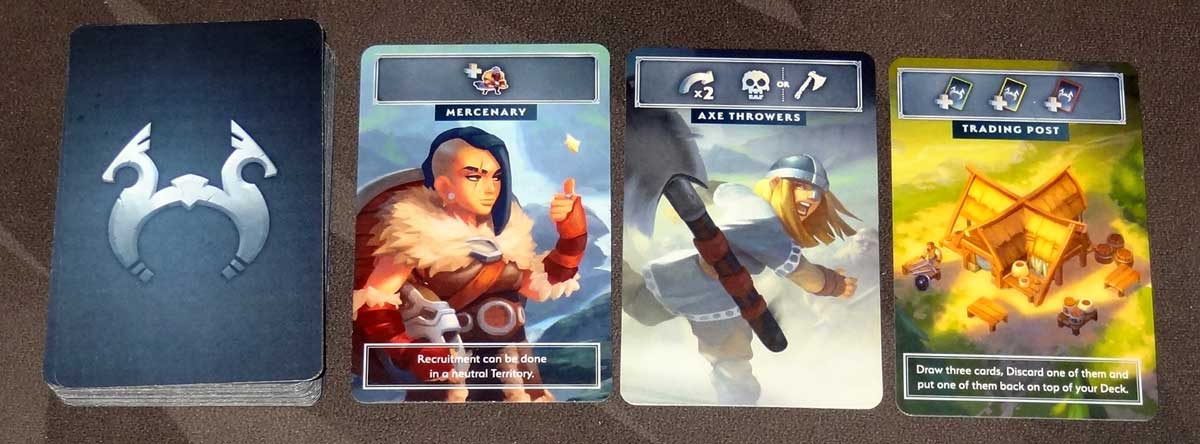
Start: Each player draws 4 cards from their own deck. Reveal as many cards as there are players from the development deck.
Actions: This is where the bulk of the game happens. Unlike many deck-building games, you won’t usually play out your whole hand on your turn. Instead, players will take one action at a time, going around the table in turn order, until everyone has passed. There are several possible actions.
- Play a card: Put a card from your hand into your active area to use its effect. You may additionally play any number of flash cards, marked with a lightning bolt, before or after your main card.
- Wait: Put a card into your active area, but do not use its effect.
- Replace a card: Put a card into your active area without using it, pay 1 rune, and draw a card from your deck.
- Remove a card: Pay 2 runes, and remove a card from your hand and return it to the box.
- Upgrade: Put a card into your active area without using it, pay 2 runes, and put one of your level 2 clan cards into your hand.
- Pass: Discard your hand and all cards in your active area, and then choose one of the face-up development cards and place it on top of your deck. You will no longer take actions for the rest of this round. If you are the first to pass, you also take the first player marker for the next round.
Harvest: Each player collects resources (food, wood, and runes) from the territories they occupy; some territories have resources printed on the tiles, and some buildings also produce resources. Each player also collects fame (points) for closed territories they occupy: 1 point if the territory only spans 2 tiles, and 2 points if it is larger. The Altar of Kings building also produces 3 fame if you control it, whether the territory is closed or not. You may trade resources with the supply at a 3:1 ratio.
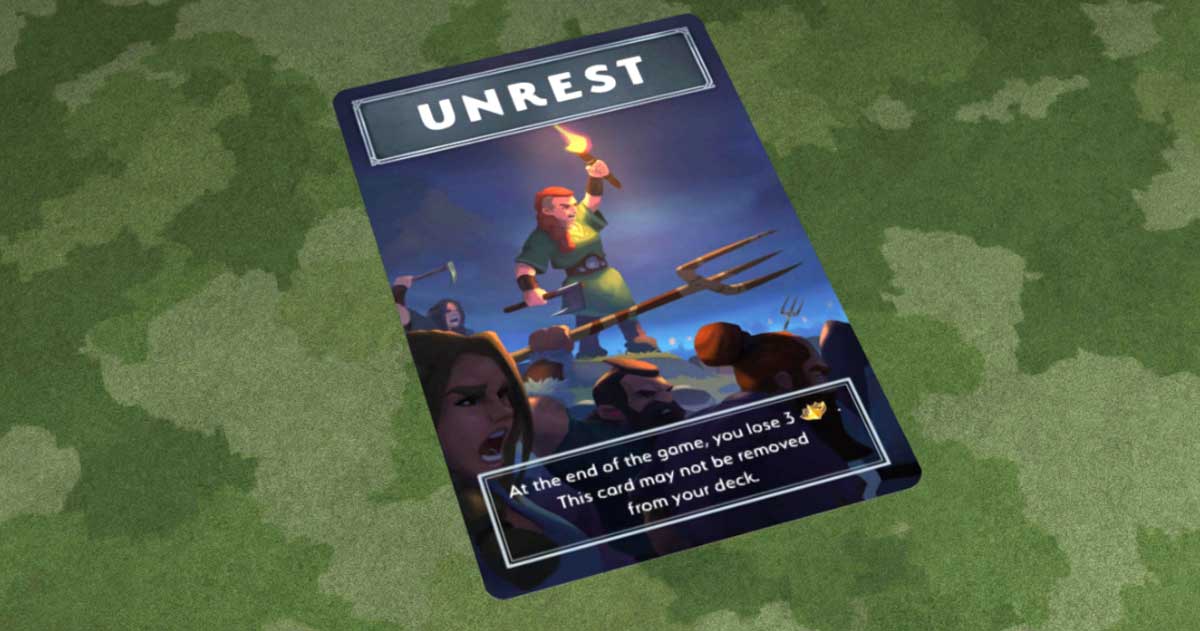
Winter: Each player must pay resources for the winter: the more warriors you have, the more food and wood you must pay. If you cannot pay all of the required resources, you pay as much as you can, and then take an Unrest card from the supply and place it on top of your draw pile. Unrest cards will cost you 3 points at the end of the game, and cannot be removed from your deck.
End: Check if anyone controls 3 territories with large buildings, or if the development deck has run out. If so, the game ends. Otherwise, start back at the beginning of the next round.

Most of the cards have some combination of the four actions seen on the starting cards: Recruit, Move, Explore, and Build.
- Recruit: Add a warrior from your supply to a territory you control.
- Move: Move any number of warriors from one territory to an adjacent territory. Moving over a mountain (the solid lines) requires 2 movement points.
- Explore: Draw a tile from the stack and add it to an open territory that you occupy.
- Build: Spend wood and add a building from the supply to an empty building space in a territory you control.
If you move into a territory occupied by another player, then you stop and fight. Each player counts up their combat points: each warrior is worth 1 point, plus an additional point if you feed it 1 food. Some buildings provide defensive combat points, and sometimes the movement card may give you extra combat points (shown as axes). Each player also rolls the combat die once. Axes provide additional combat points, and skulls (which can be found on some cards, buildings, and the dice) are casualties that remove one opposing warrior from the territory. If one player runs out of warriors, the other player automatically wins the fight. Otherwise, the player with more combat points wins, with defenders winning ties. The loser must retreat to an adjacent territory that either belongs to them or is unoccupied.

There are several types of buildings available: small buildings cost 1 wood, and large buildings cost 3 wood. Buildings can only be built on the spaces of the matching size; the carved stones may only be built in spaces that also show a carved stone. Some buildings provide resources or points during the Harvest phase. Others help in combat, either by adding combat points or casualties. The training camp allows you to recruit an extra worker when you recruit in that territory. The Forge lets you draw an extra card at the beginning of the round. You can’t build more than one of each building within a single territory.
Buildings, once placed, are typically permanent. If you take over a territory through combat, you also gain the benefits of any buildings in that territory.
Game End
At the end of a round, if any players control at least 3 closed territories with large buildings, then the game ends. The player with the most such territories wins, with ties going to the player with more points.
Otherwise, if the development deck runs out, then the 7 rounds are over. Players gain 1 point for every 3 resources they have left in their reserves and lose points for Unrest cards. The player with the most points wins. Ties are broken by number of territories, then number of units on the board, then number of buildings on the board.
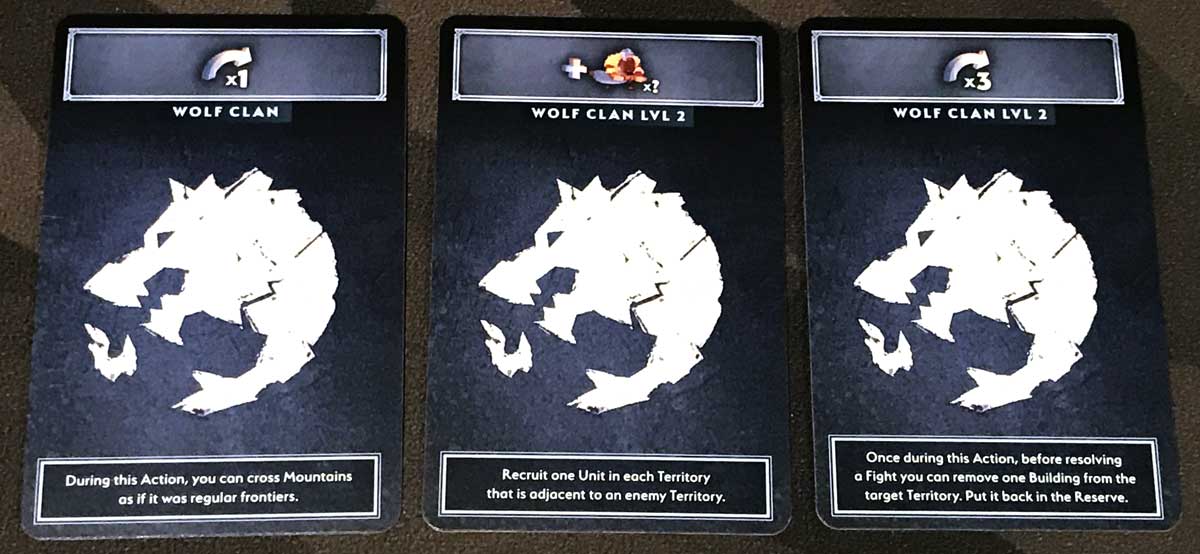
Clan Powers, Warchiefs, and Other Extras
Each clan has three unique cards that nobody else has access to: the level 1 card starts in your deck, and the level 2 cards can be added using the upgrade action. These cards—combined with your clan power—will give you an edge in a particular area. For instance, the Wolf clan is aggressive and has the ability to move over mountains more easily and build up troops on contested borders. They can even raze a building before a fight, tearing down an enemy’s defenses. The Raven clan has some powerful movement abilities, including one that lets them move to any open spot on the map. The Goat clan is great at building and finding food for winter, so you can hunker down and let the other clans battle it out. I’m not sure how the clan powers will be represented in the core game since they were printed on the clan boards in the prototype.

The Warchief expansion gives each player an additional figure, the warchief, who can be recruited just like any other warrior. However, the warchief is worth 2 combat points, and each one has its own special power: the Bear warchief can ignore one casualty; the Stag warchief can bring in an adjacent unit for a fight; the Raven warchief can reroll the combat die once.

The Creatures of Northgard expansion was added as a stretch goal and will be included for all Kickstarter backers. It includes various creatures that roam the map, wreaking havoc. My prototype only included a sample card and miniature: the wolves prevent territories from generating resources and points. Creatures can also be hunted for points, and since their movements are directed by the cards, you may be able to use them to your advantage if you know where they’re going.
Why You Should Play Northgard: Uncharted Lands
I first saw a prototype of Northgard: Uncharted Lands last year at Gen Con, when I met with Jim Gaudin from the Crowdfunding Agency, a European company that works with publishers to run their crowdfunding campaigns. He showed me several upcoming projects (including Reigns: The Council, which I reviewed last fall), and I was immediately intrigued when he described Northgard as a deck-building game with tile-laying and area control. At the time, I don’t think he described it as a 4X game, but it does indeed include exploration (laying down new tiles), expansion (recruiting more people), extermination (combat), and exploitation (collecting resources and constructing buildings). I’ve been waiting eagerly for a chance to play it ever since.
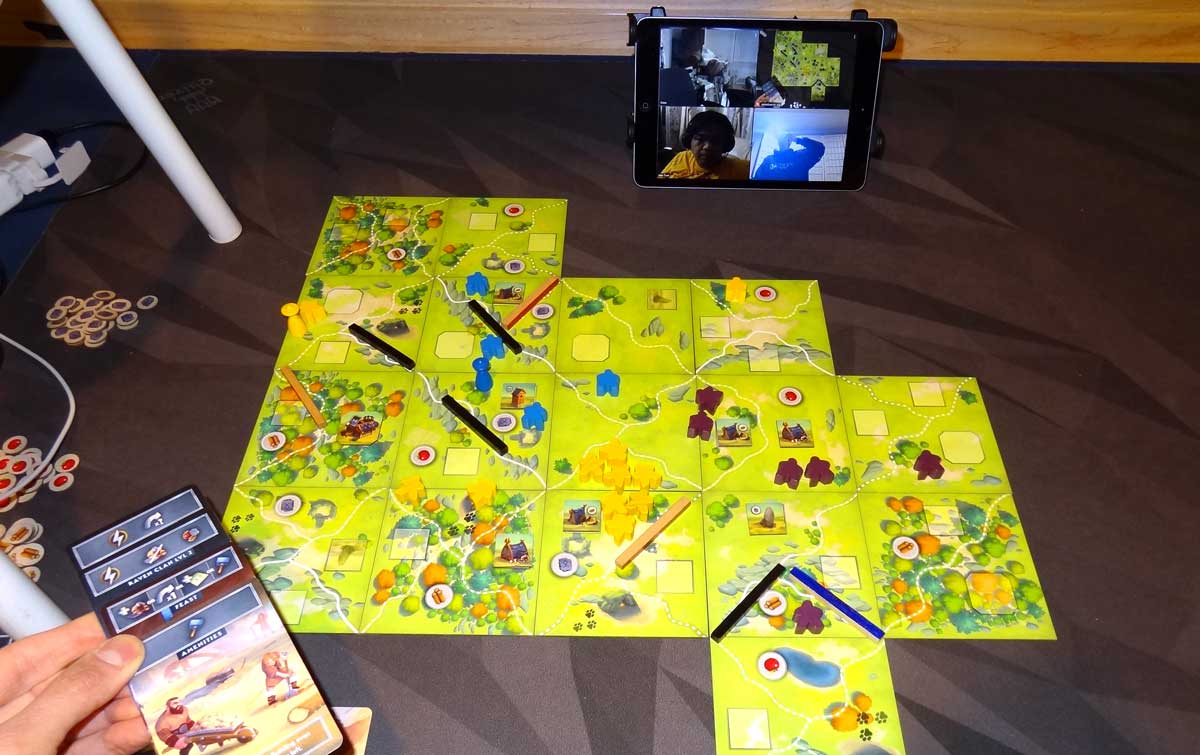
Alas, when the prototype arrived well in advance of the Kickstarter launch, we were a month into lockdown and I wasn’t hosting game nights. I did manage to use my video chat setup to play once with two very patient friends, using extra wooden bars to highlight territory borders and holding cards up to the camera. It was enough to get a sense of how the game flowed, but definitely not the ideal way to play, especially considering the flow of the game where each player takes one action. Part of the strategy involves deciding when to act and when to wait, and if you know what cards your opponents are holding, then it removes that bit of the unknown from the equation.
So, I’d been waiting on access to the Tabletopia module, which was in development, and finally got access last week just in time for Gen Con online. (The module is not yet public.) I gathered up some friends and strangers and set up a couple of plays. Finally!
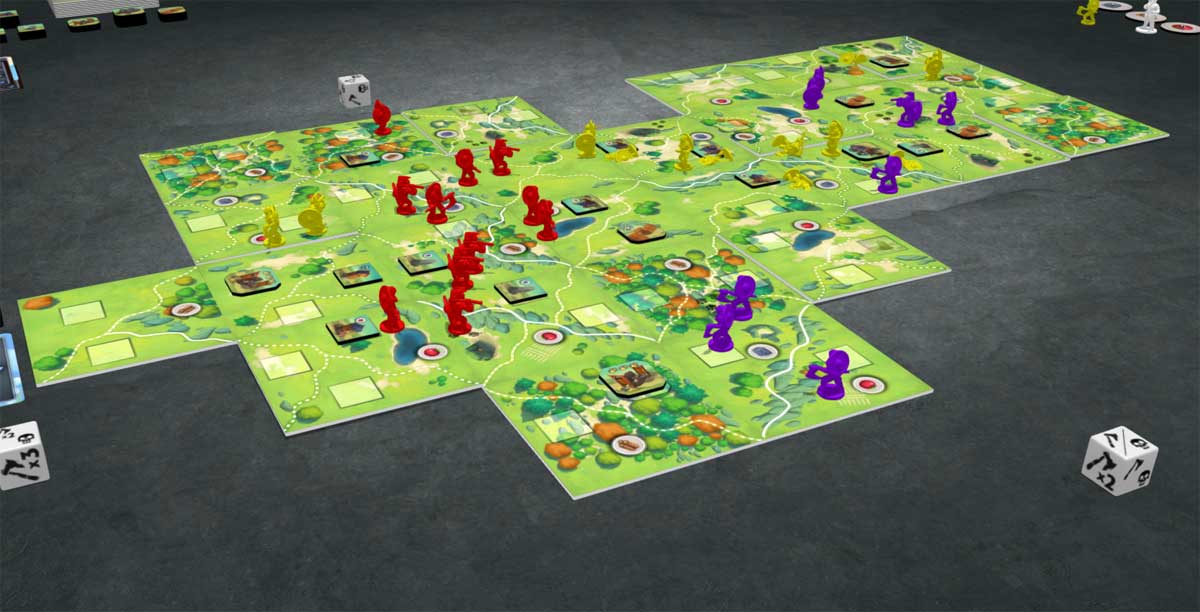
I described Northgard as both a deck-building game and a 4X game, but both of those descriptions may bring to mind impressions that don’t quite fit here. Here’s how it stands out from those genres.
It’s definitely deck-building in that each player has a personal deck, starting with basic cards and gradually adding other cards to it. However, the deck-building is a little slower paced, because there are only two ways to add cards to your deck: using the upgrade action to add one of your two level 2 clan cards, or taking a development card when you’ve passed for the rest of the round. Since the game ends after 7 rounds, you’ll only add 9 cards at most to your deck—and you won’t even get to use the last card you take because the game is over. (This last bit seems funny to me—it seems like you could put just 6 cards per player into the deck instead, and then the game ends when everyone has passed on the round where there aren’t any cards in the market.) Runes can be hard to come by, which also limits how quickly you can upgrade to get those clan cards, and how many cards you’ll want to trash from your deck. It gives the deck-building a different feel, knowing that you will only add so many cards, but also that you’ll only get so many actions in the entire game. Unless you have a Forge to draw more cards, you’ll get to play 28 cards over the course of the game, assuming you never pass early while you still have cards in your hand.
The flow of the game is also different: I haven’t seen a deck-building game in which players go around taking actions one at a time from their hand of cards. It takes a little getting used to, but it results in shorter downtimes between turns. Sure, the total time that you’re waiting for other players to take actions may be the same over the course of the game, but you don’t have to wait as long for your turn. In addition, it also gives players the ability to react more quickly. Somebody just recruited in a neighboring territory? Maybe you can build a fort before they invade. The “wait” and “replace” actions haven’t been used as extensively in my plays, but they can be effective—you sit and burn some cards (or runes), and find out what your opponents are up to before you make your moves. On the flip side, using flash cards to play through all of your actions early gets you first choice of the development cards. Sometimes it’s even worth skipping a few potential actions if there’s a card you really want—but, again, you have to weigh that against the fact that you’ll only get about 28 card plays over the course of the game. How many of those actions is it worth giving up?
With 73 development cards (and counting, based on the stretch goals), you’ll only use a fraction of them each time you play. Unlike a game like Dominion, where you know all the different cards that will be available and can start building up a strategy from the beginning, Northgard is more tactical: you’ll only see a couple of cards to choose from each round, and you won’t know what’s in the rest of the deck. That will make the game feel different each time you play, and makes it harder for a player to develop a “go-to” card combination that always works.

As for the 4X aspect, I acknowledge that there are a lot of different types of 4X games now, and they’re no longer all huge, hours-long games, but for whatever reason, I’m still more inclined to think of something like Heroes of Land, Air & Sea as a 4X game than a pocket-sized game that includes the 4 Xs. Northgard: Uncharted Lands is somewhere in between; it’s pretty streamlined and play can go pretty quickly. Actions are typically short except when movement results in combat, so as soon as somebody has declared that they’re not playing any additional flash cards, the next player can take their turn. I would say that the game is heavy on exploration because you’ll need to add more tiles in order to find resources to harvest and places to build. Expansion comes naturally as you add more warriors when you get spread out (or gear up for a fight), but it’s not a goal in itself—you just add more people to the board. Extermination will depend a lot on the gaming group’s playstyle: despite the fact that we were playing a game about Viking warriors, many of the people I played with tended to be a little hesitant to go on the offensive, preferring to explore and tend to their own territories. But I’ll get into that a little more later. Exploitation is a bit lighter here: you collect resources and use them for buildings, which then provide some sort of bonus. But there’s no tech tree or engine-building, and anything you create can be taken by an invading player.
Okay, back to combat: the amount of combat will certainly depend on playstyle, but I have found that there’s at least one condition that will start driving even the more peaceful players to combat: a threat of immediate victory. You get points for controlling closed territories, but if you can close off three territories and build large buildings in them, you can win regardless of points—as long as you can hold them until the end of the round. Typically when a player has reached two such territories, that’s where things can start getting aggressive. That player may invade, if they feel they it’ll be easier or quicker to take a third territory by force rather than exploring and building. Or other players may attack, hoping to take away a territory to prolong the game.
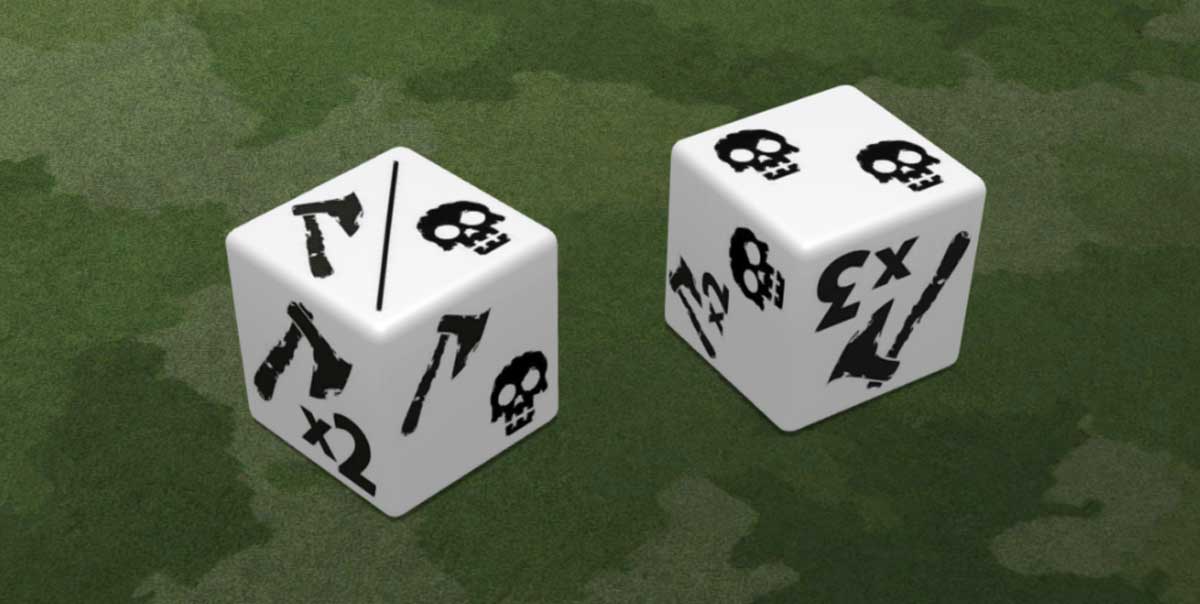
Combat does have some luck involved in the dice rolls, but the dice can only help you so much—they can add up to 3 combat points or two casualties. If the invader can invest in enough troops (and feed them all), then you can overwhelm the defender no matter what they roll. As a defender, you can use buildings to help protect a territory, but that also means the territory isn’t producing as much. Larger territories will let you build more things—defense and resources!—but that also means a lot more borders for potential invasions, and because they’re worth more points, they’re also more likely to be targeted. Even though combat is the most involved single action, it’s pretty simple and resolves quickly, so the game doesn’t get bogged down.
I really like the variation in the clan powers and warchief powers, and the way that they let you try out different approaches to victory. However, I will warn that the Wolf clan’s power is dependent on attacking—you get 1 food each time you attack (whether you win or lose)—which means that players who don’t like to be aggressive may feel like they’re not getting the benefit of a special power. It’s definitely a game where you want to play to your clan’s strengths if you want to be competitive.
Winter will cost you, but it doesn’t feel terrible—not like feeding your family in Agricola. Your first three warriors don’t cost anything, for instance, and if all of your troops are on the map, it’ll cost 4 food and 1 wood. Hopefully, if you’ve recruited that many people, you’ve managed to use them to secure some territory that produces resources (or taken advantage of your clan abilities). You do have to account for it because Unrest cards are doubly bad: not only do you lose 3 points, but since you’re only drawing 4 cards per round, losing 25% of your actions for a round is particularly costly. But the winter costs don’t seem crippling, and so far in my games, nobody has gone hungry.
Like many games, the theme in Northgard involves colonizing a “new world,” though (as is often the case) it avoids much of the messiness of actual colonization. There are no natives as you explore, just forests to harvest wood and fields to gather food. As with the island of Catan, it’s a pristine land, conveniently unoccupied and ripe for the taking–not even a lone robber to interfere with your plans. I’ve seen a couple cards that imply a human presence: mercenaries that can be recruited to neutral territories, implying alliances from … somewhere? I’m not sure if the implication is that when you “explore” you’re automatically clearing out any people who live there, but the game mostly omits this aspect, and the only fights that take place are with other rival clans.
Overall, I’m impressed with Northgard: Uncharted Lands. I think it looks great and uses deck-building in a new way. The gameplay is fast-paced and has a nice flow to it, keeping players engaged and thinking throughout. The project funded quickly after launch and has already reached a number of stretch goals, so the finished product will have much more content than what I saw in the prototype. If you like area-control games and Vikings, it’s definitely worth checking out.
For more information or to make a pledge, visit the Northgard: Uncharted Lands Kickstarter page!
Click here to see all our tabletop game reviews.
![]() To subscribe to GeekDad’s tabletop gaming coverage, please copy this link and add it to your RSS reader.
To subscribe to GeekDad’s tabletop gaming coverage, please copy this link and add it to your RSS reader.
Disclosure: GeekDad received a prototype of this game and access to the Tabletopia module for review purposes.
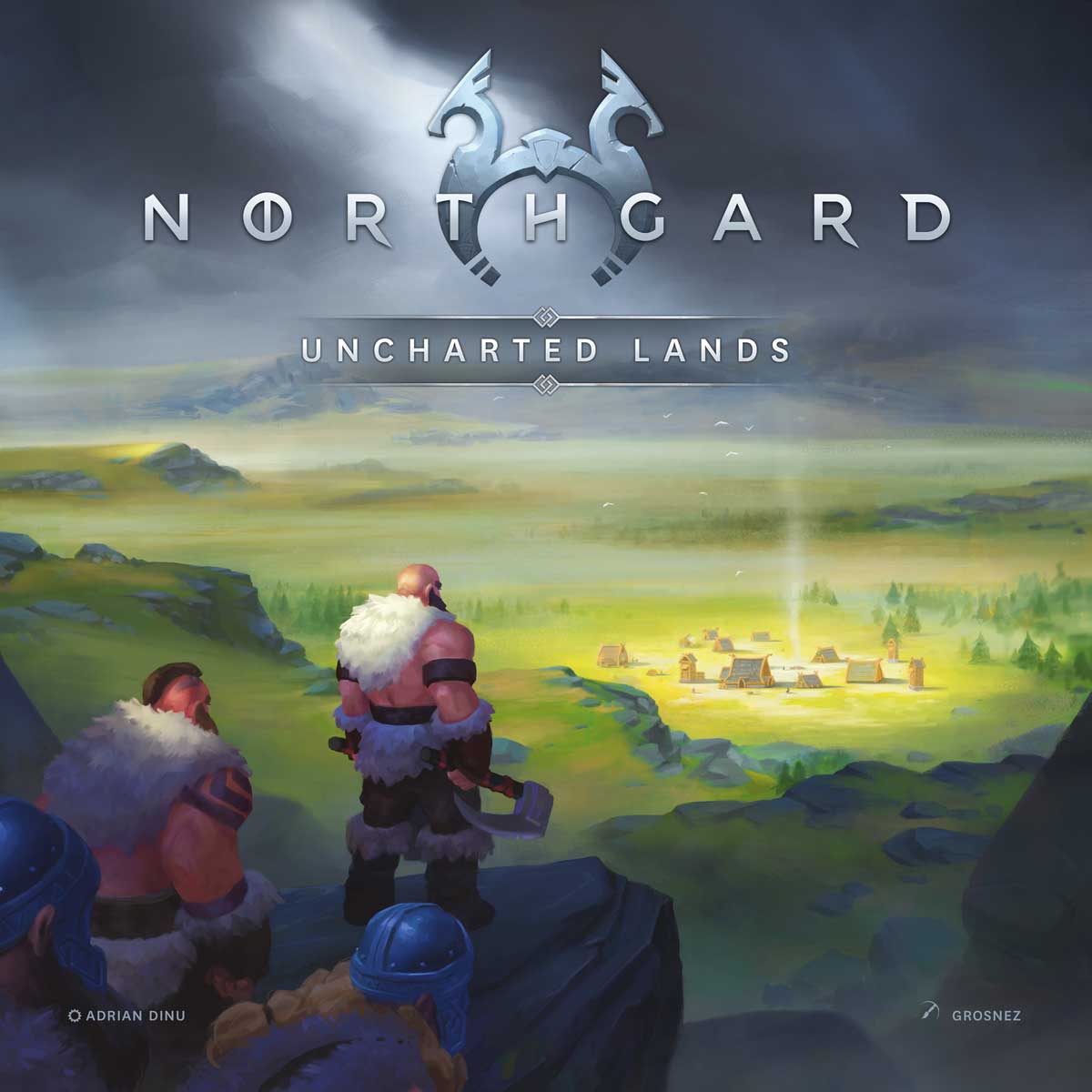


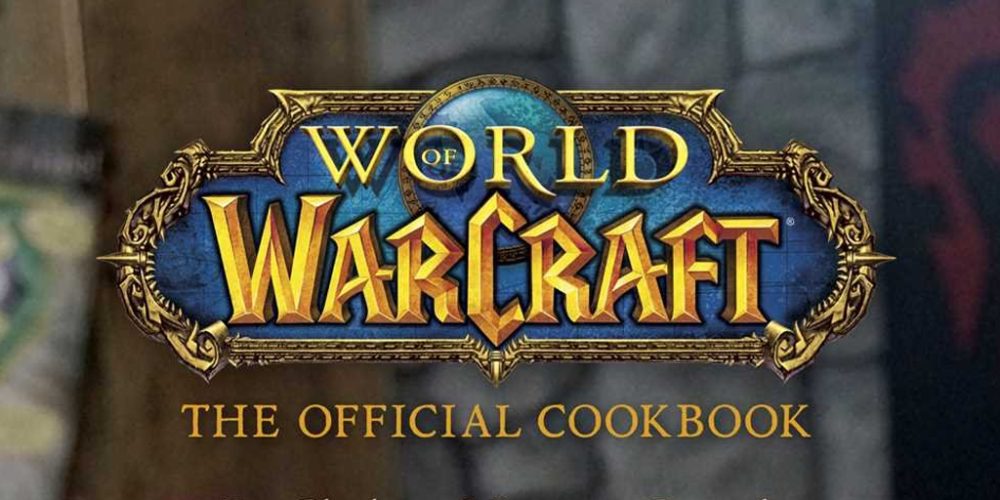

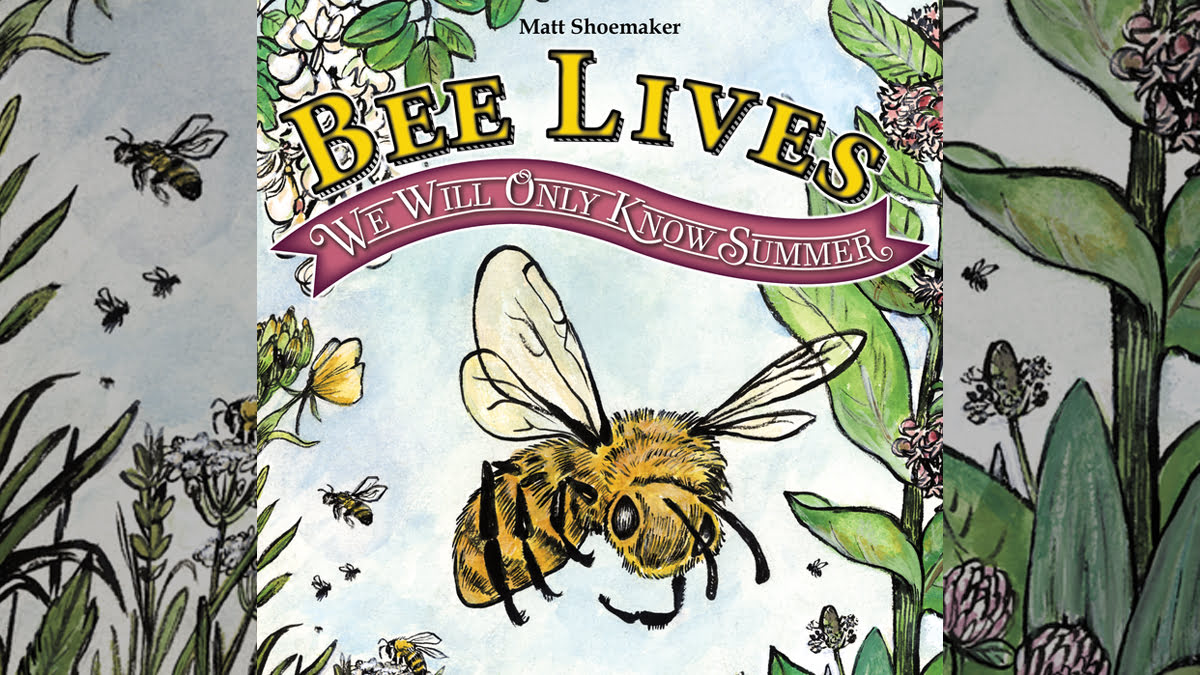
Nicely written and donhe my friend!
I’ve just started writing just recently and realoised lot of articles merely rehash old ideas but add very littke of benefit.
It’s terrific to read a beneficial article of some real value
to your readers and me.
It is on my list of details I need to emulate as a new blogger.
Reader engagement and content quality are king.
Some excellent thoughts; you have most certainly managed tto get on my list of blogs to follow!
Keep up the excellent work!
Cheers,
Ruy